| Main page » Polish armour » armoured trains » PZ 11 (German) – Polish artillery – Steel Panthers – what's new | 
|
||
| © Michal Derela, 2001 | Updated: 23. 7. 2024 | ||
| Main page » Polish armour » armoured trains » PZ 11 (German) – Polish artillery – Steel Panthers – what's new | 
|
||
| © Michal Derela, 2001 | Updated: 23. 7. 2024 | ||
This page is a supplement to the history of the Polish armoured train Nr. 51 "Pierwszy Marszałek". It contains additional photo material depicting former Polish wagons, captured in 1941 by the Germans and used in the armoured train Panzerzug 10b (Panzerzug 10 Kampfzug B), in August 1943 renamed to Panzerzug 11. Additional Polish connection of this train was a place of its final destruction on Polish soil. See also pages on Panzerzug 21 and Panzerzug 22 trains.
Note: links without an underline are external, directing to Wikipedia articles.
On 22 September 1939, the Polish armoured train Nr. 51 (former "Pierwszy Marszałek" – First Marshall) was abandoned by the crew near Kovel, after three weeks of combat, cut off by Soviet units invading Polish eastern territories and bombed by Soviet aircraft. The train was repaired afterwards, converted to a wide gauge (1524 mm), and put into Soviet service as the BP (Bronyepoyezd, bepo – armoured train) of the 77th NKVD Regiment from the 10th NKVD Division, otherwise known just as NKVD BP Nr. 77 (it belonged to the NKVD internal forces, responsible among others for railway's protection, not to the Red Army). It retained its Polish armament of four 75 mm cannons wz.02/26 and 7.92 mm machine guns wz.08 Maxim (up to nine in each artillery wagon), as well as the armoured locomotive Ti3-2. It should be noted, that the train consisted of two former Soviet artillery wagons, of a standard type built at Krasnoye Sormovo plant in Nizhny Novgorod about 1919, during the Russian Civil War. They were captured by the Poles in 1920 and used in the war against the Soviets afterwards. By 1939, such wagons were completely extinct in the Soviet military (two more were later seized after a Soviet occupation of Latvia, one of them was finally found in German PZ 26). The Soviets apparently did not use the train's assault wagon (of WWI Austro-Hungarian origin), because a standard composition of Soviet armoured trains consisted of two artillery wagons only.
After German attack on the USSR, the BP Nr. 77 was captured by German units on 7 July 1941 at Kopyczynce, south of Tarnopol, following a several day combat. After repairs in Germany (possibly Wittenberge or Eberswalde) the train was commissioned into German service by 1 December 1941. The Germans made an unusual decision to form one strong armoured train Nr. 10 – Eisenbahn Panzerzug 10 (PZ 10) of two armoured trains captured on the Soviets. Peculiar thing was, that both of them were originally Polish trains. Although the new train was treated as one military unit, it consisted of two independent parts: Kampfzug A (Panzerzug 10a, or Kampfzug I; former Polish train Nr. 53 "Śmiały", in the Soviet service BP of the 75 NKVD Rgt) and Kampfzug B (Panzerzug 10b, or Kampfzug II; former Polish train Nr. 51 "Pierwszy Marszałek"; BP of the 77 NKVD Rgt). The commander of the whole unit was Hauptmann Ernst Naumann, and since 19 March 1942: Haupt. Paul Berger. The train was formed in Berlin military district.
The subject of this page is Panzerzug 10b (Kampfzug B) only. Its initial composition, since November 1941 untill May 1942, was:
The train's main armament remained original four 75 mm guns wz. 02/26, designated 7,5 cm FK.02/26(p). The Germans removed Polish nine 7.92 mm wz. 08 Maxim (original German MG 08) heavy machine guns and replaced them with non-fixed light machine guns of the crew. Only in late 1942 Polish drum MG mountings with big vertical apertures were replaced by simple loop-holes. Only other visible external change was adding side plates protecting couplings. The train also was fitted with a wagon with one 20 mm Flak 38 AA-gun. There is no such mention in literature, but newly revealed photograps show, that the train soon acquired also an immobilized PzKpfw III E/F/G tank with 50 mm L/42 gun, on a typical Soviet two-axle flatcar, to strengthen its firepower.
The composition of Panzerzug 10b did not include a former assault wagon of Nr. 51 train, which was captured as well and used from July 1941 in the German improvised track protection train "Leutnant Marx" of the 221st Protection Division (Sich.Div.; later the 707th Infantry Division), demobilized in summer of 1942 in Rembertow base[1].
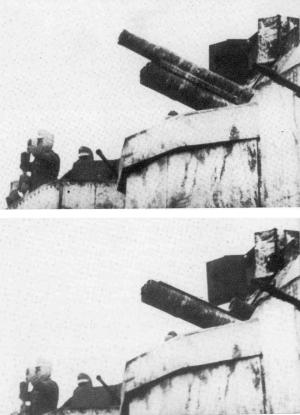
As of February 1942, the crew of Kampfzug B were 2 officers, 13 NCO and 62 soldiers, and they were armed with 19 light machine guns, 31 rifles, 4 SMG and 46 pistols (the crew of the whole Panzerzug 10, with auxiliary and command sections, were 9 officers, 49 NCO and 158 soldiers).
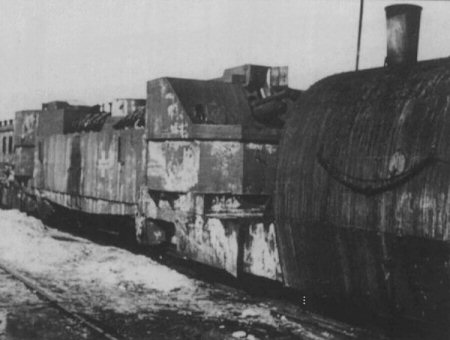
| A shooting sequence of a 75 mm gun in the PZ 10b (January 1943) [5] → ← Panzerzug 10b in early 1942. Ex-Polish armoured locomotive Ti3-9 is visible (note chains, typical for this particular locomotive only). [1] |
After completing and training of the crew, the whole Panzerzug 10 was ready on 2 February 1942, and moved to the Eastern Front in the Army Group South. The train came into action initially as a wide-gauge one (1524 mm). Upon arrival, Kampfzug A was sent to necessary repairs at Darnitsa, while Kampfzug B was subordinated to the 2nd Army and sent for an anti-partisan operation "Michael" in the area of Lgov – Vorozhba in February.
| The Panzerzug 10b in an action against partisans near Lgov, February
1942. Both artillery wagons and a locomotive of PZ 10b are visible (a spar is sticking out of a machine gun loop-hole – possibly an aerial pole?). A low-profile open infantry wagon on the right, fitted here with 2 cm AA gun, was a typical primitive design for German first wave broad-gauge armoured trains (PZ 26 to 31). An other photograph suggests, that PzKpfw III tank was already included behind the farther artillery wagon. The photograph was previously known in much worse quality only [1] (improved in 7/2024). |
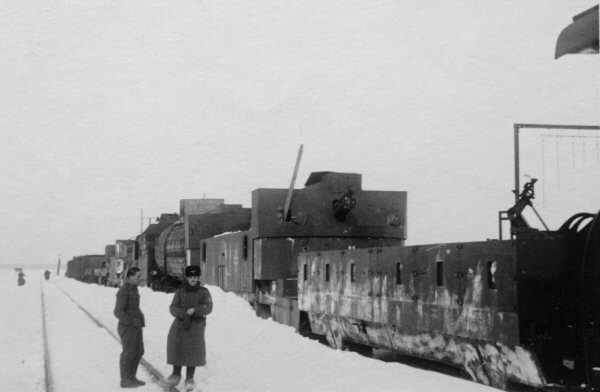 |
| Previously unpublished photograph of the same action. Some tanker wagon has been included in the train, as well as a passenger coach (on the left) and several other wagons. According to Sawodny, the low-profile infantry wagon has been borrowed from the PZ 28 train. It is not clear however, if it is not the train's own AA wagon, a look of which is not known. |
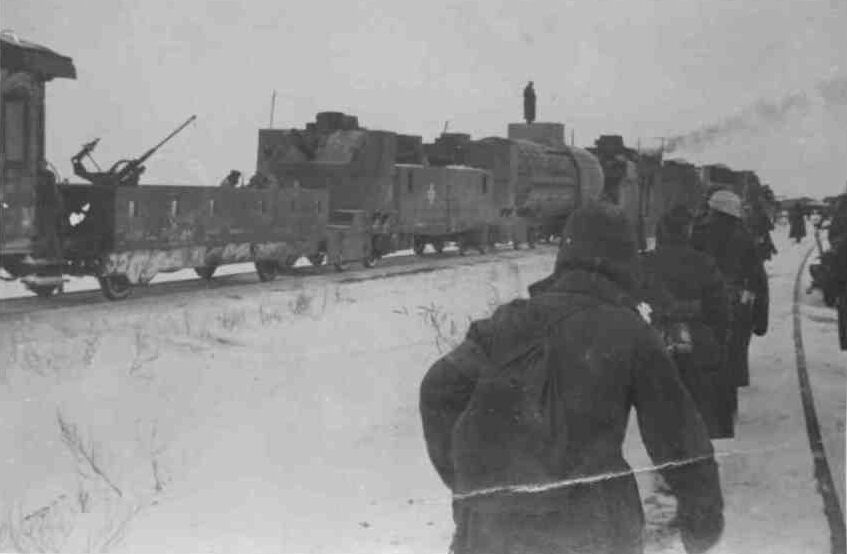 |
In March 1942 the Panzerzug 10b came to Kharkiv, which was threatend by Soviet counteroffensive, where it joined the PZ 10a. Both trains were stationed in Kharkiv until 23 April 1942, then operated in the area of nearby Belgorod until July 1942. During Soviet offensive, on 18 May the PZ 10b was bombed by aircraft and damaged[1].
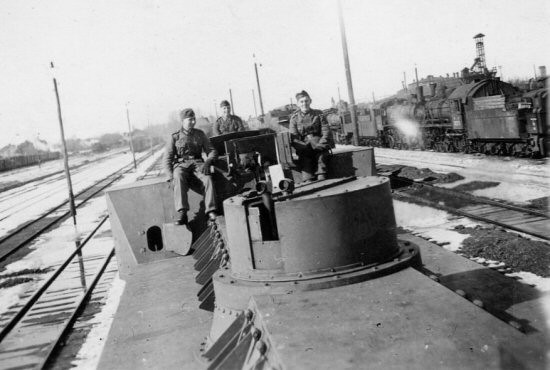 | An interesting view of the roof of the artillery wagon of former "Pierwszy Marszalek", Kharkiv, early 1942. On the foreground, former anti-aircraft MG turret is visible, now: observation turret with a binocular periscope inside. The anti-aircraft MG turret and its pedestal were Polish modification of original wagons. An artillery turret is turned towards the camera, probably with a cannon dismounted. The hole on the left is a MG port. Probably there is an open roof hatch before the soldier in the background. A construction of "Krasnoye Sormovo" type armoured wagon's roof is clearly visible – significant pairs of rims protected ventilation hatches between them. [1] |
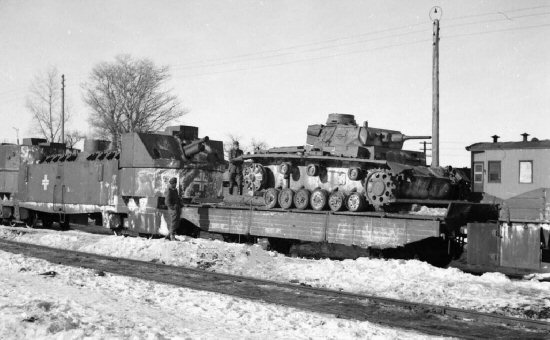 | Previously unpublished photograph from a similar period, with an immobilized PzKpfw III tank (Ausf. E, F or G) on a typical Soviet flatcar, utilized to strengthen the train's firepower. |
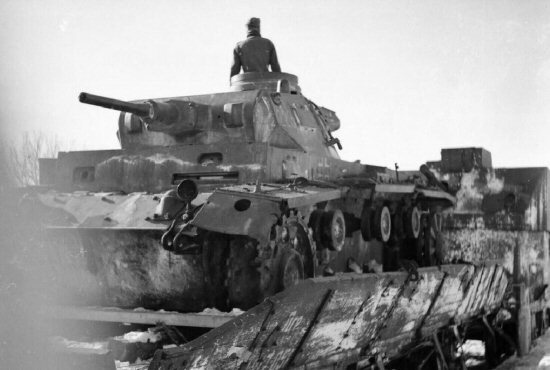 | Another photograph of the train's PzKpfw III tank. The tank is fitted with 50 mm L/42 gun and has modifications, like frontal applique armour (photograph added in 2024) |
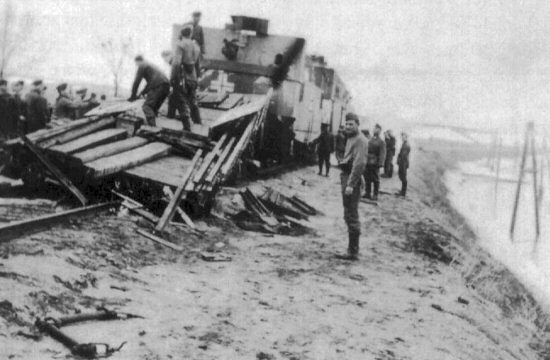 | A flatcar of Kampfzug B derailed by Soviet partisans in spring of 1942, in an area of Vorozhba. Note rails and sleepers for track repair on the flatcar. [1] |
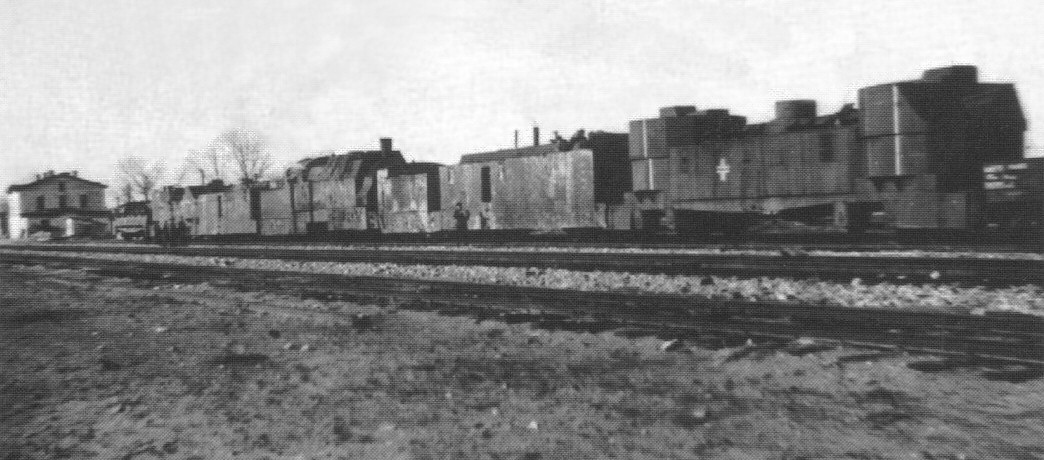 |
| The Panzerzug 10b in late composition around 1942-1943. From the right: an artillery wagon of former "Pierwszy Marszalek", a new infantry and anti-aircraft wagon (a former Soviet heavy artillery wagon, with asymetrical doors), a spare tender, an armoured locomotive 57 1064, the second infantry and AA wagon (a former Soviet light artillery wagon), the second artillery wagon of the "Pierwszy Marszalek" and a flatcar (a part of a flatcar is also seen on the right). The train had such composition between July 1942 and May 1944. [1] |
In July 1942 there started a refit of the train in Kharkiv workshops, during which it was strengthened. Because all the railway on the captured area had been converted to a standard gauge 1435 mm by that time, the trains were reconverted to the standard gauge then[5]. The PZ 10b received two additional armoured infantry wagons, converted from artillery wagons captured on the Soviets with artillery turrets removed. They were similar, four-axle, of the standard pre-war Soviet BP-35 type train. Originally they were: a heavy artillery wagon PT-33 type (or earlier) with a single 107 mm cannon, and a light artillery wagon, probably PL-35 or PL-37 type, with two 76 mm guns. Each of them was armed in German service with a single 20 mm (2 cm) FlaK 38 AA-gun only, above one of wagon's ends, in a former barbette. The train was also fitted with an auxiliary tender before the locomotive. Armoured wagons received additional heater stoves, and drum mountings for machine guns were eventually replaced with simple loop-holes (for MG-13 or MG-34 LMG's or rifles) – presumably, for better heat insulation.
The locomotive was changed to a standard German locomotive of armoured trains number 57 1064 of the class (Br) 5710-35 (former Prussian G10 class). The locomotive, however, used less typical, early pattern of armour, applied in Kharkiv workshops (a photo below [1]). According however to Magnuski, the PZ 10 received new locomotives only from 24 September[2].
Sawodny only generally gave a new silhouette of the train from June 1942, with new wagons and locomotive[1], but July is more consistent with an information on gauge conversion[5], and is indirectly confirmed by Magnuski, who wrote about Kampfzug A being refitted from 13 July to 2 October[2]. One photograph of PZ 10b however suggests, that the train might have received at least one new wagon already in early spring (not published here, with old locomotive and drum MG mountings).
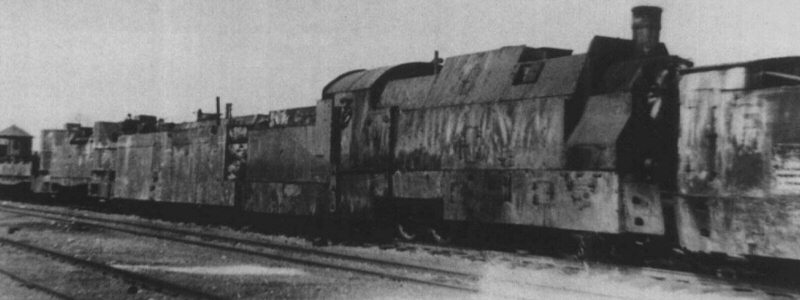
In November 1942 the train was used to anti-partisan tasks in Bakhmach – Homel area. After 23 November both parts of the PZ 10 were moved towards the front, to the outside of Stalingrad pocket, defending Chir. They were assigned to the Army Group Don. They took part in several skirmishes and artillery duels, among other in recapture of Tatsinskaya on 28 December 1942 (with PZ 28), after the Soviet raid. After the defeat at Stalingrad in January 1943, the trains were protecting a retreat of German units in the Donets basin, with the Army Group South. During the whole spring the trains were used in combat, and PZ 10b suffered some losses in crew and damages to the equipment. On June 1 both PZ 10 trains were moved to Western Ukraine: to Kovel – Sarny – Kiev area to anti-partisan duties (it is noteworthy, that the Polish train Nr.51 operated in Kovel – Sarny area in 1939 against the Red Army). On 13 June 1943 the Kampfzug B was heavily damaged by a mine, and the repairs lasted about month.
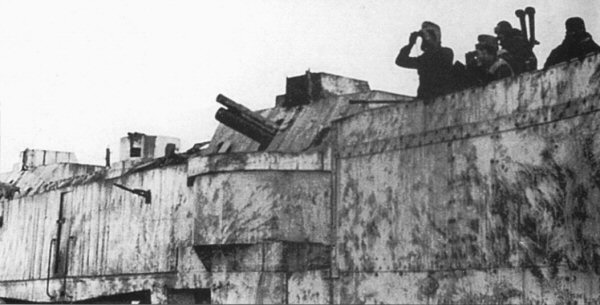 |
An interesting view of PZ 10b artillery wagon, probably during winter 1942/43. Former Polish observation turret is still present, and there is apparently a chimney next to it. 2 cm Flak barrel is visible upon the infantry and AA wagon on the right. [5] Below: photographs from a similar period in thorough winter camouflage. Polish drum MG mountings have been replaced with simple loop-holes for German LMGs. Note a machine gun in the turret. [7/1,6] |
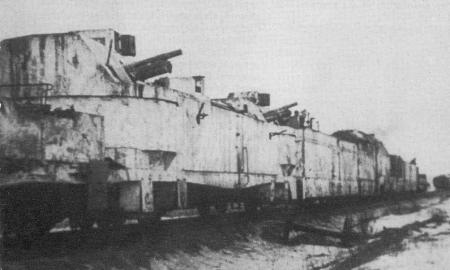 | 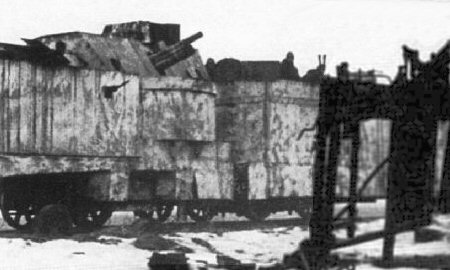 |
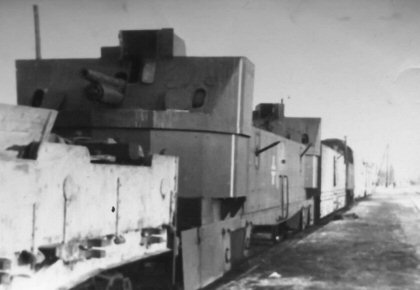 |
| The modified PZ 10b, possibly in autumn 1942 (lack of a winter camouflage). Well visible are simple loop-holes in places of former rectangular mountings. |
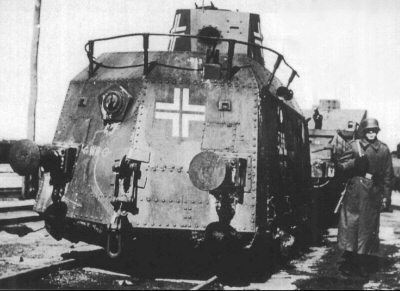 |
| A captured Soviet armoured draisine DTR, used for a reconnaissance in the PZ 10b. [1] |
On 31 July 1943 the Panzerzug 10 was finally split into two separate units: Kampfzug A remained Panzerzug 10, while Kampfzug B was renamed Panzerzug 11. On August 11, the PZ 11 was moved to the front again. During following months, it was used in heavy retreat fighting in Eastern Ukraine, in Dnepropetrovsk area, in Army Group South. Among others, it drove back Soviet tanks attack on the line from Lyubotyn to Poltava in August. In September the train defended a bridghead over the Dnepr, near Dnepropetrovsk. On 19 October it was damaged in a heavy fighting near Piatykhatky. On 17 November, after repairs, it returned to frontline service in the Znamenka, then Bobrinskaya (Bobrinets?) area. In December it took part in retreat fighting in that area and was withdrawn to Western Ukraine – on 21 December to Rivne, then in January 1944 to Zdolbuniv and in February to Dubno. It next patrolled and fought against partisans on Krasne Brody – Dubno line. During next Soviet offensive, the train broke through towards Tarnopol on 6 March, along with PZ 69.
In the first half of 1944 the train underwent further modernization and repair in Lviv workshops. It most likely received two anti-tank wagons (Panzerjaegerwagen), armed with a 75 mm (7.5 cm) KwK 40 AT-gun in PzKpfw IV tank turret, and two flatcars (Panzerträgerwagen) carrying light tanks PzKpfw 38(t) (armed with 37 mm guns). The single 20 mm AA guns FlaK 38 were probably replaced with quadruple guns 20 mm Flakvierling 38. The crew were 6 officers, 25 NCO's and 90 soldiers then. During all the service the train had also armoured scout draisines assigned: captured Soviet ones (on a photo on the right - DTR type one), or armoured cars Panhard 204(f) riding on rails.
In summer of 1944, two heavy armoured motor rail cars (Panzertriebwagen) PT 16 and PT 18, armed with two guns 76,2 mm FK 295/1(r) each, were subordinated to PZ 11 (PT 18 was of the Soviet MBV D-2 type). At that time they operated in the Army Group North Ukraine (former AG South). On July 17 they were moved north to the front and then broke through a Soviet encirclement near Rava Russka and withdrew to current Poland's territory. The train suffered losses in a battle near Zamość. Next, between 20 and 22 July, they were used in a defence of Lublin. After Lublin had fell, the train (along with PT 16 and PT 18) broke through an encirclement again on 24 July, losing one wagon and a locomotive, replaced with another one (not armoured?). On 27 and 28 July it suffered losses defending the crossing of the San river at Rozwadów, then it was withdrawn farther to Dębica and to Cracov for repairs.
In the end of 1944 the train was operating in south-eastern Poland (in Kielce – Miechów – Radom area) in the Army Group A, and was stationed at Kielce, still with the PT 16 and PT 18. On 12 January 1945, a great Soviet offensive started in that area. Finally, the Panzerzug 11, former Polish "Pierwszy Marszałek" ended its combat career on 13 January 1945 near Chęciny (a small town south of Kielce, with famous royal castle ruins). Probably the train was abandoned by its crew, when it could not retreat because of a destroyed bridge on the Nida river[3] (along with the PZ 25 train). The PT 18 was destroyed in Kielce on January 16, while the PT 16 managed to get away (its story will be a subject of other page).
| Panzerzug 11 near Ternopil, Ukraine, March 1944. The train received evident camouflage (unfortunately, this is the last photo of the train known so far). [1] |
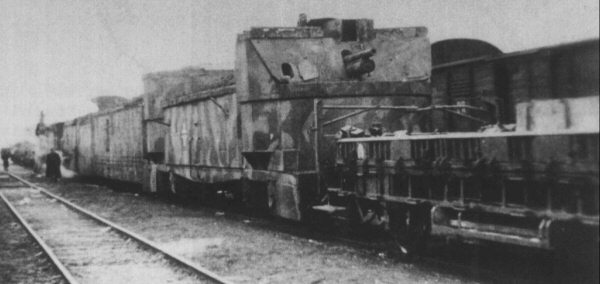
|
All comments, corrections and additional pictures or better quality ones are welcome
Sources:
1. Wolfgang Sawodny: Die
Panzerzüge des Deutschen Reiches 1904-1945; EK-Verlag, Freiburg, ISBN 3-88255-678-1
2. Janusz Magnuski: Pociag pancerny 'Śmiały' w trzech wojnach; Pelta; Warsaw 1996
3. Janusz Magnuski: Panzertriebwagen nr 16; "Militaria" vol.1 nr.1
4. H. & W. Trojca: Panzerzüge 1 - Pociagi pancerne cz.1; Militaria, Warsaw 1995
5. Wolfgang Sawodny: German Armored Trains on the Russian Front 1941-1944; Schiffer, 2003
6. Wolfgang Sawodny: German Armored Trains in World War II; Schiffer, 1989
7. Wolfgang Sawodny: German Armored Trains in World War II Vol. II; Schiffer, 1989
8. photographs taken by anonymous unsigned German soldiers.
Updated:
2024. 07. 23 - small ammendments, one photo added, two improved
2023. 01. 08 - substantial modernization, added 5 photos and improved others
2023. 01. 03 - modernized layout
2019. 02. 04 - improved, revised
2010. 01. 11 - improved
Main page – Polish armour – Armoured trains – Polish artillery – Steel Panthers
All photos and pictures remain the property of their owners. They are published in non-commercial educational and research purpose. Photographs were mostly or exclusively taken by anonymous German soldiers.
Text copyright to Michal Derela, © 2001-2024